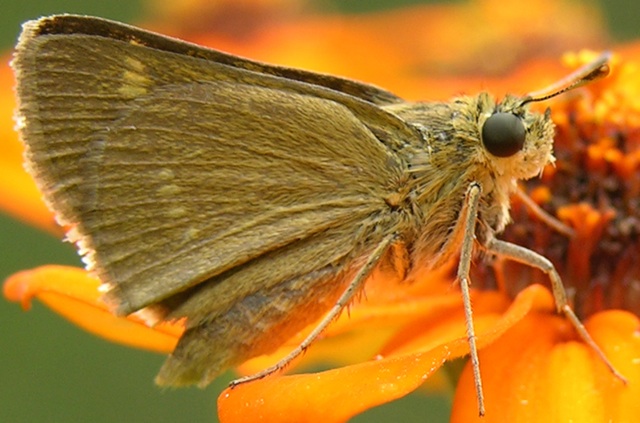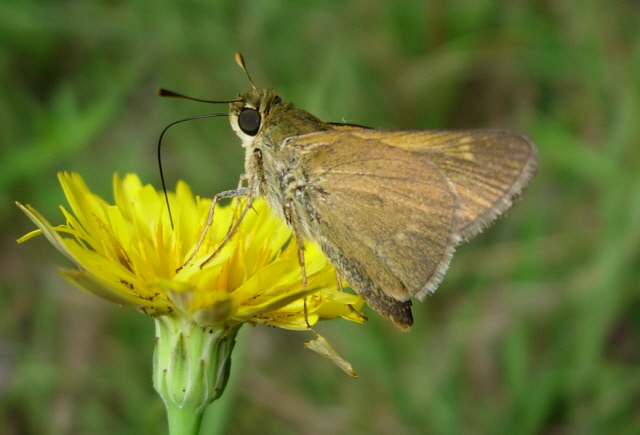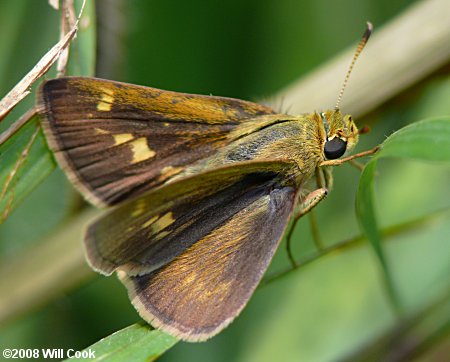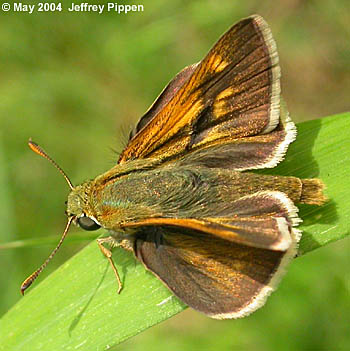|
| Common Name | Crossline Skipper by Roger Rittmaster => Durham Co. NC
[View PDF]
 Click to enlarge Click to enlarge
[Google Images] GBIF [Global Distribution ] BoA [Images ] iNaturalist |
| Scientific Name | Polites origenes
|
| Link to BAMONA species account. |
| Map | Click on a county for list of all database records for the species in that county.
 |
| Distribution | DISTRIBUTION: Statewide; found in all three provinces, though of spotty distribution in parts of the Coastal Plain. However, presumed to occur in all counties.
|
| Abundance | ABUNDANCE: Declining in the past few years. Formerly fairly common to locally common in the Piedmont and Sandhills, but currently mostly fairly common (at best), and uncommon in some areas. Fairly common in the Mountains; least numerous in the Coastal Plain, where rare to uncommon. This is a much more common species in NC than the Tawny-edged Skipper, though the latter can be the more numerous of the two over parts of the Coastal Plain (such as in savannas and flatwoods near the coast). There were a handful of single-party counts of at least 150 individuals as late as 2009, but this might be a "thing of the past".
|
| Flight | FLIGHT PERIOD: Two broods in NC; present from mid-May to early July, and mid- or late July to mid-October, in each of the three provinces.
|
| Habitat | HABITAT: Widespread, but mainly in areas of native grasses; habitats include overgrown fields, wooded edges, powerline clearings, openings in Longleaf Pine (Pinus palustris)/scrub oak woods, etc. Present in savannas, but less numerous there than the Tawny-edged Skipper. Far outnumbers that species in dry sites. Neither species occurs in gardens, arboretums, pastures, and cultivated weedy fields (except in very rare cases).
|
|
| | Plants | FOOD AND NECTAR PLANTS: The foodplants are native grasses, with Tall Redtop (Tridens flavus) being favored, according to the literature. The nectar plants are very varied. White Colicroot (Aletris farinosa) is favored by individuals of the first brood; in fact, it is often the most commonly seen skipper nectaring on this flower. Blazing-stars (Liatris spp.) are a favorite of the second brood.
|
| Comments | COMMENTS: This species can easily be confused with the Tawny-edged Skipper, and worn individuals of both can be confused with worn individuals of darker species such as Northern Broken-dash, Dun Skipper, and Little Glassywing. Do not expect to identify every Crossline and Tawny-edged; I frequently have trouble, and I undoubtedly have mis-identified them on a number of occasions. Nonetheless, the Crossline can be numerous along dry woodland borders and upland powerline clearings, especially in the Piedmont and Sandhills.
Sadly, since about 2012 or 2013, this and many other skippers of powerline clearings and other sites where native grasses are common (including old fields, and wide wooded borders) have clearly declined. Though some decline of these and other species can be attributed to severe ice and snow storms in late February and March, it appears that herbidicing of powerlines and road margins has negatively affected skippers whose foodplants are native grasses such as Tall Redtop, broomsedges (Andropogon spp.), and Little Bluestem (Schizachyrium scoparium). This situation bears watching in the next few years, but the beneficial mowing of powerline clearings by utility companies may be a thing of the past.
|
State Rank | S4S5 | | State Status | |
Global Rank | G5? [G5] | | Federal Status | |
| Synonym | Limochores origenes
|
| Other Name |
|
|
|

 >>
>>


